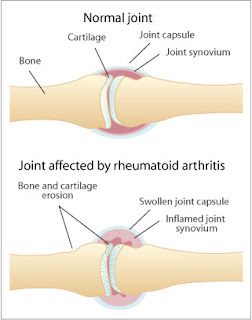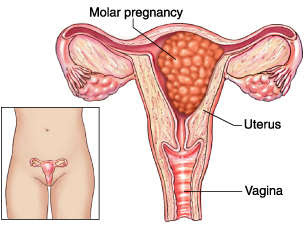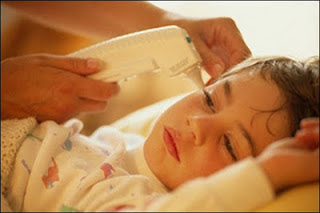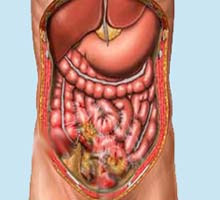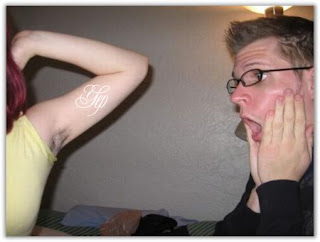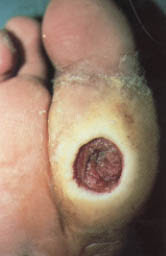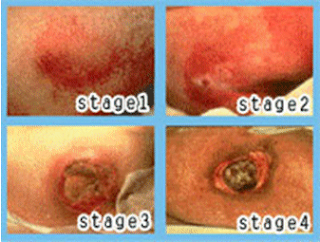A pressure sore (bed sore) is an injury to the skin and/or the tissues under the skin. Constant pressure on an area of skin reduces blood supply to the area. Most commonly this will be the sacrum, coccyx, heels or the hips, but other sites such as the elbows, knees, ankles or the back of the cranium can be affected.
Cause pressure sores include:
- Constant pressure on the skin and tissues. This is by far the most common cause of pressure sores.
- Sliding down in a bed or chair, forcing the skin to fold over itself ("shear force").
- Being pulled across bed sheets or other surfaces (friction burns).
- Irritation of the skin from things such as sweat, urine, or feces.
As we get older, our skin gets more thin and dry and less elastic, so it is easier to damage. Poor nutrition-common among older people and people who cannot move easily-makes these natural changes in the skin worse. Skin in this condition may easily develop a pressure sore.
Symptoms of a pressure ulcer are:
- Red skin that gets worse over time
- The area forms a blister, then an open sore
Pressure sores most commonly occur on the
- Elbow
- Hips
- Heels
- Ankles
- Shoulders
- Back
- Back of head
Pressure sores are grouped by their severity. Stage I is the earliest stage. Stage IV is the worst.
- Stage I: A reddened area on the skin that, when pressed, does not turn white. This is a sign that a pressure ulcer is starting to develop.
- Stage II: The skin blisters or forms an open sore. The area around the sore may be red and irritated.
- Stage III: The skin now develops an open, sunken hole called a crater. There is damage to the tissue below the skin.
- Stage IV: The pressure ulcer has become so deep that there is damage to the muscle and bone, and sometimes to tendons and joints.
Physical Examination Pressure Ulcers in Elderly
1. General Condition
Generally, patients come to the sick and agitated or anxious as a result of damage to the integrity of the skin is experienced.
2. Vital Signs
Normal blood pressure, rapid pulse, increased temperature and respiration rate increased.
3. Examination of the Head and Neck
a) Head and Hair
Examination includes the shape of the head, deployment and change hair color as well as an examination of the wound. If there is injury to the area, causing pain and skin damage.
b) Eye
Includes symmetry, conjunctiva, pupil reflexes to light and impaired vision.
c) Nose
Includes examination of the nasal mucosa, cleanliness, nostril breathing does not arise, there is no discharge.
d) Oral
Note the presence of cyanosis or condition dry lips.
e) Ear
Note the form of hearing loss due to foreign bodies, bleeding and wax. In patients who bet the rest by his side, is likely to occur in areas of ulcer ears.
f) Neck
Knowing the position of the trachea, carotid pulse, presence or absence of jugular vein and gland enlargement linfe.
4. Examination Chest and Thorax
Inspection form of the thorax and lung expansion, auscultation respiratory rhythm, vocals premitus, the extra noise, heart sounds, and extra heart sounds, percussion thorax to look for abnormalities in the thorax area.
5. Abdomen
Form flat or flat stomach, bowel sounds decrease due to immobilization, there are masses because of constipation, and abdominal percussion hypersonor if abdominal distention or tense.
6. Urogenital
Inspection abnormalities in the perineum. Usually clients with paraplegia ulcers and catheter attached to urinate.
7. Musculoskeletal
A fracture in the bone will cause the client bet rest in a long time, so
a decline in muscle strength.
8. Examination of Neurology
The level of consciousness assessed with GCS system. Value could decrease if there is pain (neurogenic shock) and heat or high fever, nausea, vomiting, and stiff neck.
9. Physical Assessment of Skin
Assessment involves the skin around the area of the skin including the mucous membranes, scalp, hair and nails. Appearance of skin that needs to be assessed is the color, temperature, humidity, dryness, skin texture (rough or smooth), lesion vascularity.
That must be considered by the nurse is:
a) The color, affected by blood flow, oxygenation, temperature and pigment production.
The lesions were divided into two: a) the primary lesion, which occurs due to a change in one component of skin. b) secondary lesions are lesions that appear after the primary lesion. Preview lesions that must be considered by the nurse that the color, shape, location and kofigurasinya.
b) Edema
During the inspection of the skin, the nurse records the location, distribution and color of the region edema.
c) Humidity
Normally, humidity increases due to increased activity or high ambient temperatures of dry skin can be caused by several factors, such as dry or moist environments that are not suitable, inadekuat fluid intake, the aging process.
d) Integrity
That must be considered is the location, shape, color, distribution, if there is drainage or infection.
e) Cleanliness skin
f) vascularization
Bleeding from the blood vessels and produces petechie echimosis.
g) Palpation of skin
To note that the lesions on the skin, moisture, temperature, texture or elasticity, skin turgor.
10. examination Support
1) A complete blood
Certain increase in hemoglobin concentration early show, with respect to the displacement or loss of fluid and to detect nutritional deficiencies clients. If there leukocytosis due to loss of cells in the inflammatory response to injury and edema. Serum glucose increased due to the stress response.
2) Biopsy wound
To determine the number of bacteria.
3) Swab culture
To identify the type of bacteria on the surface of the ulcer.
4) Preparation of clinical pictures
Created to demonstrate the nature and extent of skin disorders or ulcers and used for improvement after therapy.

